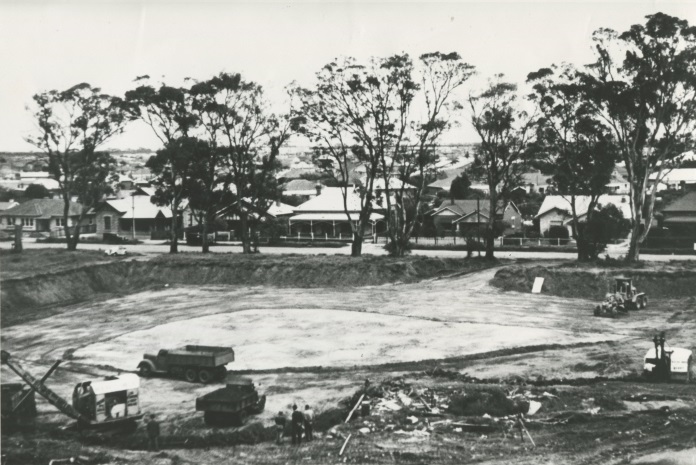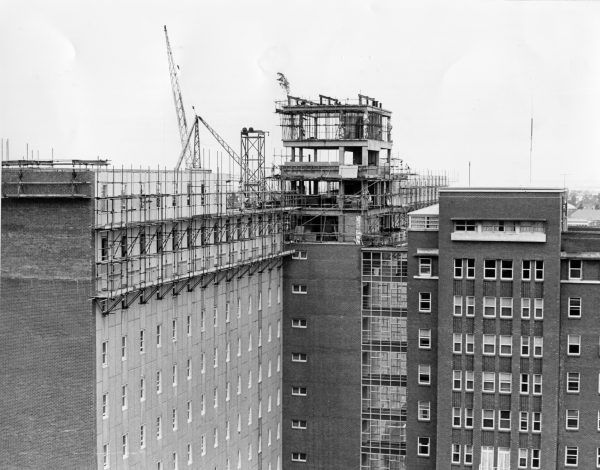Opened in 1954, the building was designed as a nurses’ home, but initially used as temporary maternity hospital.
The Beginnings
The land that The Queen Elizabeth Hospital Nurses’ Home was built on, originally belonged to Captain Henry Simpson. He gave the property as a wedding present to his daughter Jessie Hall Simpson and George Alexander Connor in 1865. They named the 15-acre property ‘Silveracre’ and built a 10 room house on what is now Woodville Road. They sold the property to the government in 1943, although it would be over 10 years before the first patient was admitted.

The hospital was considered an urgent post-war project. Due to the scarcity of post-war manpower and material shortages, the hospital was constructed in stages. The first stage included the Nurses’ Home and outbuildings such as the Kitchen Block, the Boiler House and Workshops.
In 1951, the building contract was won by F Fricker Ltd and preparations began on building the East Wing of the Nurses Home. As the East Wing took a long time to build, the West Wing contract was given to Stephenson and Turner. They used the quicker method of poured concrete to construct the red brick building.

There was a pressure at the time for maternity beds as a result from soldiers returning form the Second World War. The maternity section of the new hospital wasn’t ready for occupancy, so the East Wing of the Nurses’ Home, which had been completed was adapted as a hospital.
Matron Gladys Tanner Oral History 1988
Official Opening
Although the Premier announced the opening date in parliament and the press made it public, the opening was a quiet affair. On 6 September 1954 at 7.30am, an orderly opened the front doors of the temporary maternity hospital to patients. As well as admitting mothers waiting to give birth, the ante-natal clinic also opened that day, and sixteen mothers came for consultation on opening day. The first baby was born at 12.33am the following morning (7 September 1954).
The Baby’s mother, Mrs ES Swiggs, was a patient of Dr BM Jolly, a member of the Honorary Staff. However, Dr Jolly suggested that since Dr Ross [Medical Superintendent] had played such an important part in the birth of the new hospital it would be most fitting for her to deliver the first baby. Philip Daryl Swiggs was therefore delivered by the Medical Superintendent of the maternity section.
Ian LD Forbes, ‘The Queen Elizabeth Hospital, Woodville, South Australia, 1954-1984.
It wasn’t until three months later that the official opening ceremony took place.

The Chairman of the Hospital Board (Dr JW Rollison) presented his mother, Mrs ES Swiggs, of Glyde Street, Albert Park, with a framed colour portrait of the Queen … seated on the dais were the Premier and Cabinet Ministers, the Speaker of the SA Parliament (Sir Robert Nicholls) and Members of Parliament, Senior Government Officers and Union Representatives. Workmen on the eight-storey hospital building opposite watched the ceremony from the rooftop. Mr Playford said The Queen Elizabeth Hospital was the biggest undertaking of its kind in the State
The Advertiser, 18 December 1954
Maternity Hospital
Because of the pressing demand for maternity beds, both patient wards and staff accommodation were in the one building. Floor allocation in the temporary Maternity Hospital / Nurses Home were as follows:
- Basement: store and linen services;
- Ground floor: administration, ante-natal and post-natal clinics and staff dining rooms;
- First floor: labour ward;
- 2/3/4 floors: patient wards;
- Fifth Floor: RMO and nursing staff accommodation;
- 6/7 Floors: nursing accommodation; and
- YWCA Hostel: overflow of nursing staff.
The bedroom of the Medical Superintendent was built on the floor assigned to male Medical Registrars, complete with communal toilets, urinals and bathrooms. The planners had not considered that the boss may be a woman. When a female, Dr Heather Ross, was appointed, another room was converted into a separate bathroom especially for her.
Ian LD Forbes, ‘The Queen Elizabeth Hospital, Woodville, South Australia, 1954-1984.
In 1957, the purpose-built maternity hospital opened, and all patients treated in the temporary building were transferred over.
Education
The Nurse’s Home sole use now was for nursing accommodation and training purposes. Located in this building was The Nurses Training School.

In the planning for the hospital the architect forgot to provide general nursing classrooms. A small classroom was available on the ground floor for midwifery students, but nothing for general nursing. However, social rooms had been provided in both the East and West Wing and these were converted for teaching.
When I drew the attention of the Administrator to the fact that we hadn’t classrooms, the Chairman said “oh well, you’ve got two lots of social rooms, they can use the social rooms”. And, as you would know, a building built for social rooms does not adapt to a classroom situation very easily. They had social rooms in the East Wing and in the West Wing, so we converted the social rooms in the East Wing, which were adjacent to the midwifery classroom and tried to adapt them. And that sufficed for a time, but as the numbers grew it became increasingly difficult, and when the Board decided to build an extension onto the ground floor, it had some new classrooms.
Matron Gladys Tanner Oral History, 1988
A demonstration room was also set up for nursing education. This room was located on the second floor and was “fully equipped to resemble a hospital ward even to the lifelike dummy patient on which trainees could practice without fear of impairing their patient’s well being.” Ian LD Forbes, ‘The Queen Elizabeth Hospital, Woodville, South Australia, 1954-1984

Expansion
In the mid-1960s, there was a growing need for more nursing accommodation, particularly to house the newly trained male nurses. Construction on an upper floor extension of The Queen Elizabeth Hospital Nurses’ Home began in 1967. Completed in 1969, The Queen Elizabeth Hospital Nurses’ Home now had nine floors.

The first male nurses to train at The Queen Elizabeth Hospital were three men from metropolitan mental health services: Keith Edwards, Ron Bruggemann (Enfield Receiving House) and Edward Ameer Beg (Parkside Mental Hospital) in 1962. They graduated in 1964 becoming South Australia’s first male general certificated nurses. Gradually more men began nursing training and in July 1973, the hospital converted the top floor of the Nurses’ Home to accommodate male nurses.
We set aside a floor on the top level of the Nurses’ Home for male nurses. But shortly after that there was a general trend for nurses to live away from the hospital and gradually many more people lived out.
Matron Gladys Tanner Oral History, 1988
After nurses pursued independent accommodation in the 1970’s, the top section of the Nurses’ Home, which was formerly nursing residence, was handed over to the School of Nursing, and they utilised those rooms. The lower section was used for hospital administration.
Repurpose
In 1990, work began on the former Nurses’ Home to convert the space into facilities for medical research. The building was renamed the Medical Sciences Building and officially opened in June 1992 by Her Excellency, The Governor of South Australia, Dame Roma Mitchell. This provided facilities for joint University and Hospital research activity.

The building was renamed The Basil Hetzel Institute for Medical Research in 2001. This was in recognition of Professor Basil Hetzel incredible contribution to Medical Sciences. A new purpose-built research facility was opened in March 2009, opposite the main hospital on Woodville Road.
The former Nurses’ Home now stood empty and abandoned.
I think that it [living out] brought about a change in the attitude of nurses to the hospital. Something, I think, was lost, in the feeling of being a part of the hospital, as an entity. Girls, and later young men, who came to train lived in the Home, and they really became very much identified with the hospital and its surroundings. And I think that they gained a lot from each other, and they gained a lot of support, particularly the junior nurses.
MATRON Gladys Tanner Oral History 1988
Demolition
The building was scheduled to be demolished as part of an overall rebuilding of The Queen Elizabeth Hospital to modernised and expand the site.
External demolition begun on the Nurses’ Home in May 2010 with removal of the ninth-floor roof. The new facility built in its place was an overflow Carpark
Written by Jan Hooper and Margot Way, CALHN Health Museum